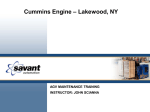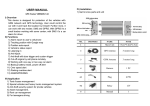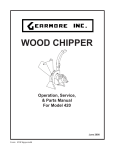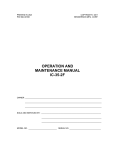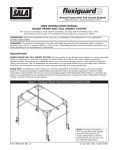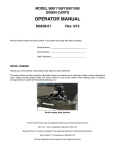Download Contents - Savant Automation
Transcript
Cummins Engine Operation and Maintenance Manual DC60 - AGV System Preventive Maintenance Contents 1 1.1 1.2 1.2.1 1.2.2 1.2.3 1.3 1.3.1 1.3.2 1.3.3 1.3.4 1.3.5 1.4 1.4.1 1.4.2 1.4.3 1.5 1.5.1 1.5.2 1.5.3 1.5.4 1.5.5 1.5.6 1.6 1.6.1 Preventive Maintenance ............................................................... 1 Introduction ..................................................................................... 1 Schedule According To Use............................................................ 1 Maintenance Schedule.................................................................... 1 Use a Record Keeping System ....................................................... 2 Required Tools ............................................................................... 2 DC60 Preventive Maintenance Sequence ....................................... 3 Visual Inspection ............................................................................. 3 Perform an Operational Test ........................................................... 3 Perform Maintenance ...................................................................... 3 Repeat Operational Test ................................................................. 3 Record Completed Actions ............................................................. 4 Corrective Maintenance .................................................................. 4 Troubleshoot the Vehicle ................................................................ 4 Repair the Vehicle........................................................................... 4 Make Adjustments .......................................................................... 4 Vehicle Lubrication .......................................................................... 8 Caster Lubrication ........................................................................... 8 DC60 Drive Lubrication and Maintenance ....................................... 9 Drive Assembly Turntable Bearing .................................................. 9 Chain Lubrication ............................................................................ 9 Rear Linkage Arm Lubrication......................................................... 9 Deck Lubrication ............................................................................. 9 Safety Laser Scanner Bumper Care ............................................... 9 Daily Checkout .............................................................................. 10 2012-March-15 Project 1683 i DC60 - AGV System Preventive Maintenance ii Cummins Engine Operation and Maintenance Manual Project 1683 2012-March-15 Cummins Engine Operation and Maintenance Manual DC60 - AGV System Preventive Maintenance 1 Preventive Maintenance 1.1 Introduction Preventive maintenance is a systematic approach to vehicle maintenance designed to prevent equipment down time by identifying potential problems before they occur. An effective preventive maintenance program, will not necessarily prevent the need for corrective maintenance, but it will allow you the time necessary to plan a corrective maintenance procedure before the need becomes immediate. This allows time for scheduling equipment down time and parts procurement. An effective preventive maintenance system should include a schedule of all maintenance actions to be completed and a method to record or keep track of the maintenance actions completed. 1.2 Schedule According To Use Maintenance must be planned; otherwise hit-or-miss servicing could easily result. This eventually leads to extensive repairs and unit failures, usually at a critical time. Your vehicle maintenance should be based upon the calendar or number of hours the vehicle operates (whichever comes first) and the environment it is used in. :NOTE: Preventive maintenance is a preventive measure. Non-compliance with the instructions and maintenance intervals can result in impaired use and damage to the vehicle. Maintenance supervisors should ensure periodic maintenance is performed on a regular basis. They should follow the recommended vehicle maintenance until situations require change in maintenance interval. They should never increase the time between a recommended maintenance action. They have the authority to shorten it when the need becomes evident. 1.2.1 Maintenance Schedule A master maintenance schedule, listing all maintenance to be performed during the year, should be maintained by the maintenance supervisor. A partial copy of the master schedule, showing only the maintenance actions scheduled in the immediate future, should be posted, in the maintenance area, so that all maintenance personnel are able to refer to it. The schedules should prescribe maintenance actions at specific intervals. The recommended interval codes for 2012-March-15 Project 1683 1 DC60 - AGV System Preventive Maintenance Cummins Engine Operation and Maintenance Manual the DC60 are listed in Table 1. These maintenance intervals should be completed by which ever comes first – the calendar interval or the time interval. The time interval refers to the AGV’s hour meter reading, which increments only when the AGV is moving. In a 24 hour operating system, the time interval (hour meter reading) will probably occur first. Table 1 Interval Codes Code Calendar Interval Time Interval M Monthly 200 Hours Q Quarterly 500 Hours SA Semi-Annually 1000 Hours A Annually 2000 Hours BA Bi-Annually (Once Every Two Years) 5000 Hours Prescribed maintenance actions should be adequately described. This ensures that the action is performed in the same manner each time it is accomplished. The schedules should enable the personnel involved to keep track of those actions completed and those which are still pending. A good maintenance practice would be to mount a schedule behind Plexiglas so that the maintenance person can mark off completed actions with a grease pencil or erasable marker. 1.2.2 Use a Record Keeping System The Maintenance supervisor should maintain a master maintenance record of all completed maintenance actions both preventive and corrective for each vehicle. This is necessary to ensure that the maintenance schedule remains flexible and helps the supervisor to predict system failures before they actually occur. 1.2.3 Required Tools Most mechanical maintenance, on Savant Automation vehicles, can be performed using standard hand tools and a torque wrench. When using compressed air, ensure that the air is low pressure, moisture and static free, and properly filtered. Most electronic maintenance can be performed using a digital multi-meter. 2 Project 1683 2012-March-15 Cummins Engine Operation and Maintenance Manual 1.3 DC60 - AGV System Preventive Maintenance DC60 Preventive Maintenance Sequence The recommended DC60 maintenance items and their intervals are listed in Table 3. Arrange your preventive maintenance tasks into logical beginnings and endings, stopping if necessary at a point that would not render the vehicle totally useless for possible entry into emergency service. 1.3.1 Visual Inspection Preventive maintenance should begin with a visual inspection of the vehicle. If the vehicle is inoperative, first repair the malfunction, then start the preventive maintenance process. Visually check and ensure that: 1.3.2 ● Bent or otherwise damaged parts are repaired or replaced using Savant Automation recommended replacement parts. ● Mechanical parts operate freely. ● Mounting hardware, such as lock washers, spacers, nuts, and bolts are present and properly secured. ● The vehicle is reasonably clean especially the compartments containing electronics, and moving or rotating parts Perform an Operational Test The visual inspection should be followed by an operational test. (See table 1). Perform the test before all maintenance actions to ensure that the vehicle operates correctly. If the vehicle is inoperative, first correct the malfunction then start the operational test. 1.3.3 Perform Maintenance Perform the scheduled maintenance. Do the procedure exactly as described on the maintenance schedule. 1.3.4 Repeat Operational Test Completed maintenance actions should be followed by an operational test to ensure that the vehicle remains operational. If the vehicle is inoperative, retrace your steps. 2012-March-15 Project 1683 3 DC60 - AGV System Preventive Maintenance 1.3.5 Cummins Engine Operation and Maintenance Manual Record Completed Actions Using the system prescribed by the maintenance supervisor, record the completed maintenance action. 1.4 Corrective Maintenance Corrective Maintenance is maintenance designed to place the vehicle back into service by repairing a known problem. In most cases, the maintenance is not scheduled. Arrange the corrective maintenance task into some logical beginning and ending. (See the “Troubleshooting” chapter for details.) The steps required for corrective maintenance include, troubleshooting, repairing, and adjusting the vehicle. 1.4.1 Troubleshoot the Vehicle Using the information gained in the visual inspection, the operational test, and as provided in this service manual, locate the failures. To effectively troubleshoot the vehicle the technician should: 1.4.2 1. Understand the operational characteristics of the vehicle. 2. Know the capacity of the vehicle and the limits the vehicle is designed to operate within. 3. Understand the designed operation of the system. The vehicle may be operating correctly but show an apparent error, due to a change in the way that the vehicle is being used. 4. Be certain that the battery is fully charged. Electronic failures may be caused by operating on a low battery. Repair the Vehicle Make the necessary repairs to return the vehicle to normal use. Use Savant Automation parts. See Spare Parts Drawing in “Parts” section for part numbers. 1.4.3 Make Adjustments When repairs are made, the technician must be aware of any necessary adjustment which might be required to ensure normal vehicle operation. See the “Repairs” chapter for information on specific repairs. 4 Project 1683 2012-March-15 Cummins Engine Operation and Maintenance Manual Table 2 DC60 - AGV System Preventive Maintenance Operational Test Test # Test 1 Verify manual operation. The AGV drives and steers using the pendant. Verify the pendant brake switch releases and sets the brake. 2 Verify the operation of all start, stop and emergency stop switches. 3 Verify the operation of all signal devices, including motion alarms, horn, warning lights, and turn signals. 4 Check to ensure that the correct laser configuration zones are loaded and set. Verify the operation of the front and rear Safety Laser Scanner Zones. 5 Check to ensure the brake immediately sets in an emergency stop condition (laser scanner actuation or E-stop button). Vehicle is to stop within the collapsible distance of the laser scanner protection zone. 6 Verify communications. “COM-OK” is displayed in the status line of the CDU. Make sure the vehicle is on the guidepath. 7 Verify “ON-Path” is displayed in the status line of the CDU. Make sure the vehicle has been initialized and is on the guidepath (See the operator’s guide). 8 Verify the vehicle navigates the path in automatic mode without losing “ON-PATH”, “COMOK”, and with little or no steering assembly oscillations. 9 Verify the opportunity charge mechanism is operating. Manually lower and raise the charge shoes using the correct output function code via the CDU (See the software section). Look for binding and proper raised and lowered positions. 10 Check the charge on battery and charge as necessary prior to putting the AGV back into service. Check battery cables and connectors. 11 Verify the operation of the powered roller deck using the manual deck switch. 2012-March-15 Project 1683 5 DC60 - AGV System Preventive Maintenance Table 3 Cummins Engine Operation and Maintenance Manual Recommended Vehicle Maintenance Monthly Checks 1 Clean battery as necessary to remove any acid or residue from outside surfaces. See the Operator Guide chapter for further information. 2 Blow dust out of motor and brake with low pressure, low moisture, and static free air. 3 Check to ensure all electrical connections are tight on the motor, encoder, brake and temperature switch. 4 Check to ensure connectors and ribbon cables are secure on all Printed Circuit Boards. 5 Check to ensure printed circuit board assemblies are securely mounted using recommended mounting hardware. 6 Clean all vehicle and electrical compartments, using low pressure, moisture and static free air, and a soft, non-conductive brush. 7 Clean the lenses on all optics on the vehicle deck. 8 Check all lights – replace bulbs as required. 9 Clean the front and rear laser scanner screens with a lint free cloth using lens cleaner or equivalent. 10 Check magnet sensors for damage and make sure that their electrical connections are tight. i.e. they must be level with floor and centered in the middle of the vehicle + 1/16”. 11 Check the MAG Sensor Calibration. See “Magnet Sensor Diagnostics” in the “Troubleshooting” section of this manual. 12 Check the GTS assembly for obvious mechanical damage (especially the track wheel surface). 13 Perform the Ground Track Sensor Diagnostic Test for the DME and Angle Encoder. Refer to “Ground Track Sensor Diagnostics” in the “Troubleshooting” section for procedures. 14 Perform the AGV Guidance/Navigation Performance Testing. See the Troubleshooting chapter. 15 Check the Opportunity Charge mechanism. Operate the mechanism using the diagnostic output function (See the Repairs Chapter). Verify proper operation and that no stress exists at the power ring terminals. Quarterly Checks 1 Check drive tire for excessive wear. Replace as necessary. 2 Check hex bolts used to secure the drive tire to the drive assembly for proper torque. Hex bolts shall be tightened to 75 foot pounds using a torque wrench and the normal torquing sequence (star pattern). 3 Lubricate the rear steer linkage arms using general purpose grease. 4 Lubricate rear casters using general purpose grease. 5 Check caster tire and mechanical parts for excessive wear. Replace as necessary. 6 Lubricate steering chains (front, rear) using an aerosol lubricant. 7 Inspect the AGV travel areas (guidepath). Verify that no excessive holes, bumps or other floor defects are noted. If any are found, repair immediately to avoid AGV/drive train damage. Clean contactor contacts using suitable contactor cleaning solvent. 8 9 6 :NOTE: Do not use emery cloth, sandpaper, or files to clean pitted or damaged contactors. Replace them using recommended Savant Automation parts. See Vehicle Spare Parts Drawing in the “Parts” section. Verify RF modem, antenna, and its cable are securely mounted using recommended mounting hardware Project 1683 2012-March-15 Cummins Engine Operation and Maintenance Manual Table 3 DC60 - AGV System Preventive Maintenance Recommended Vehicle Maintenance 10 Check RF Modem cables for wear and proper mounting, replace as necessary. 11 Grease roller deck drive shaft bearings and roller bearings. 12 Check for proper adjustment of both the left and right load stop up/down limit proximity sensors. 13 Perform the Monthly Checks Semi-Annual Checks 1 Inspect the brake rotor thickness and air gap. See the Lenze Operating Instructions in the Vendor Information chapter. (Lenze Brake type – BRK458-10E) 2 Check the motor brushes. See the Sauer Danfoss Maintenance Instructions in the Vendor chapter. 3 Perform the Quarterly Checks Annual Checks 1 Lubricate the drive assembly turntable bearing using general purpose grease. 2 Check the ground track sensor urethane wheel for wear or cracks. Replace when diameter of wheel measures below 4-7/8”. 3 Replace the ground track sensor slip ring assembly every 2000 hours. 4 Grease roller deck gears and oil roller deck chains. 5 Check oil level in deck gear reducer. 6 Perform the Semi-Annual Checks Other Checks (greater than one year) 1 Change the grease per the Sauer Danfoss Maintenance Instructions located in the Vendor chapter of this manual. Perform every 3000 hours or every 3 years. 2 Replace all sealing elements. See the Sauer Danfoss Maintenance Instructions in the Vendor chapter. Perform every 6000 hours or 6 years. 4 Change the oil in the steer motor gear reducer. See the Alpha Gear Reducer Operating Instructions in the Vendor Information chapter. Every 10,000 hours or 5 years (whichever comes first). 5 Replace oil in deck gear reducer. * Every 5 years. See the Grove Gear Reducer Installation Instructions in the Vendor Information chapter. 2012-March-15 Project 1683 7 DC60 - AGV System Preventive Maintenance 1.5 Cummins Engine Operation and Maintenance Manual Vehicle Lubrication Periodic lubrication is required to keep the DC60 AGV fully operational. The specific points that require lubrication are listed below. Maintenance personnel shall use a quality general purpose grease or machine oil when performing lubrication. 1.5.1 Caster Lubrication Lubricate casters at the locations shown in Figure 1. The lubricants recommended within this service manual may be dangerous to your health. Always follow the manufacturer’s precautions and recommendations as provided on the label of the container. :NOTE: Synthetic and mineral type lubricants should not be mixed. Figure 1 8 Typical Lubrication Point Diagram Project 1683 2012-March-15 Cummins Engine Operation and Maintenance Manual 1.5.2 DC60 - AGV System Preventive Maintenance DC60 Drive Lubrication and Maintenance See the Sauer Danfoss Maintenance Instructions for the Drive Assembly in the Vendor Information chapter of this manual. 1.5.3 Drive Assembly Turntable Bearing Use a general purpose grease (Mobil AW2 or equivalent) to lubricate the turntable bearing. The bearing has four (4) grease zerks that require grease. Remove the steer stop bolt and rotate the drive assembly to access the grease zerks. Squirt each zerk until grease emerges from the inside of the bearing. 1.5.4 Chain Lubrication Use an aerosol lubricant to lubricate steer chains and deck chains if installed. 1.5.5 Rear Linkage Arm Lubrication Lubricate the four linkage arm rod ends using general purpose grease. 1.5.6 1.6 Deck Lubrication 1. Use 10w30 weight oil to lubricate pivot joints. 2. Use 90 weight gear lubricant to lubricate gears and chains. 3. Use a good quality general purpose grease to lubricate bearings and drive shafts. 4. Use Mobil 634 synthetic gear lube or equivalent, filling to the recommended fill level of 3/4 pint. See the Grove Gear installation manual for instructions. Safety Laser Scanner Bumper Care The safety laser scanner bumpers installed on your automatic guided vehicle (AGV) are used as primary safety devices. The emitted laser light senses fixed obstacles and if the obstacle infringes on the long range detection zone the AGV slows down. When the object infringes on the short range detection zone, the AGV immediately sets its brake and stops. The laser scanner bumpers are designed to be as fail safe as possible, however, like any electromechanical device, they can fail or be inactivated. Therefore, they need to be checked daily to ensure the laser scanners are operating properly. See the Vehicle Outline Drawing in the “Drawings” chapter for the defined protection zones. 2012-March-15 Project 1683 9 DC60 - AGV System Preventive Maintenance Cummins Engine Operation and Maintenance Manual Do not disable or alter any safety devices installed on vehicle. Injury to the vehicle operator, personnel in the area, or damage to the vehicle and the materials it handles may result. 1.6.1 Daily Checkout Do not place any vehicle into service with a known safety failure. Injury to the vehicle operator, personnel in the area, or damage to the vehicle and the materials it handles may result. Laser scanner bumpers and all other installed safety devices should be checked daily before the vehicle is placed into normal operation. Repair any known problems before placing the vehicle into operation. Do not expose the scanner to fog, rain, snow, vapors, smoke or dust. Clean the screens monthly as required. 1.6.1.1 Laser Scanner Bumper Testing Only properly trained personnel should operate the automatic vehicle system and automatic guided vehicles. Use the following procedure to test safety laser scanner bumpers on a daily basis: 1. Program the loaded vehicle for automatic operation. Select proper path for the section of guidepath on which the vehicle is to be tested. DO NOT use your body to perform the next test. 10 2. Place an inanimate test object in the vehicle’s path of travel. The object must be large enough and properly positioned to cause infringement on the protection zones. 3. Start the vehicle and observe its operation as it travels the guidepath. 4. Verify the vehicle “Emergency Stops” once the laser scanner bumper senses the object. 5. Repeat this test procedure to test each laser scanner bumper installed on the vehicle. 6. If a safety laser scanner bumper fails to function as designed, make repairs to the device before returning the vehicle to normal use. The vehicle MUST be removed from normal use until the safety device has been repaired. Project 1683 2012-March-15 Cummins Engine Operation and Maintenance Manual 1.6.1.2 DC60 - AGV System Preventive Maintenance Manual Mode Safety laser scanner bumpers are NOT operational in manual mode When a vehicle is manually operated, the safety laser scanner bumpers are not operational and will not stop the vehicle. This allows vehicle movement after a collision, or when the laser scanner is damaged and needs repair. Safe operation of the vehicle in manual mode is the responsibility of the operator. Only trained operators should manually operate the vehicle. 1.6.1.3 Replacement Parts The safety devices on Savant Automation automatic guided vehicles are specifically designed and extensively tested for AGV use. Safety devices must never be altered or modified by anyone other than Savant Automation service and repair personnel. Use only Savant Automation replacement parts. See Spare Parts Drawing in the “Parts” section, for lists provided as part of this service. As part of the procedure to replace the laser scanner unit, a Savant Automation approved configuration file is downloaded into the new unit. For specific details see the Repair section of the Laser Scanner User Manual located in the Vendor Information chapter of this manual. 2012-March-15 Project 1683 11 DC60 - AGV System Preventive Maintenance 12 Cummins Engine Operation and Maintenance Manual Project 1683 2012-March-15














